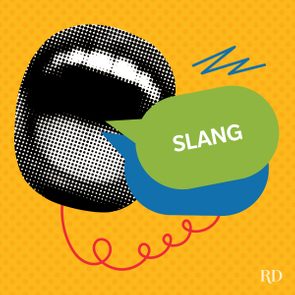Learn which punctuation mark has fallen out of favor—and why

Here’s the Punctuation Mark Gen Z Wants You to Stop Using—And It’s Not What You Think

Punctuation marks may be small, but they carry a lot of weight—shaping tone, clarifying meaning and even signaling the writer’s personality. I adore the em dash; I tend to be a bit of a drama queen and employed them long before someone decreed they were a sign of AI-generated content. And, I find there’s no more satisfying way to make your point than to put a simple period on it.
But one punctuation mark, once a favorite of authors and scholars, is quietly falling out of fashion—and a new study suggests that Gen Z isn’t just ignoring it; they’re actively turning away.
To learn what’s behind this generational shift in punctuation preference, I dug into the study and spoke to two grammar experts: Mignon Fogarty, host of the Grammar Girl’s Quick and Dirty Tips for Better Writing podcast, and Lisa McLendon, PhD, a professor of journalism and mass communications at the University of Kansas.
Read on to find out what’s going on—full stop, ellipsis, exclamation point.
Get Reader’s Digest’s Read Up newsletter for more grammar, humor, travel, tech and fun facts all week long.
What was the methodology of the study?
Babbel, the language learning platform, analyzed English-language books using a tool developed with Harvard University (Google Ngram Viewer) to investigate writing patterns over time. Their metrics data tracked the frequency of punctuation marks per word in published texts including novels, nonfiction and scientific literature.
Among the findings: In 1781, the semicolon appeared once every 90 written words. Its use in English rose by 388% between 1800 and 2006, before falling by 45% over the next 11 years. In 2000, the frequency was one semicolon every 205 words. By 2022, there was one semicolon in every 390 words; that’s a 47% decrease just from 2000 to 2022.
What punctuation mark does Gen Z dislike?

It’s the semicolon. According to the study, there’s been a steep drop in semicolon use—from once every 205 words in 2000 to once every 390 words in 2022. That historic low mirrors the rise of digital communication—and the rise of Gen Z.
For Gen Z, speed and clarity are top priorities, and their communication style comes with its own clear boundaries. They often skip capital letters in texts, consider the thumbs-up emoji passive-aggressive and definitely don’t want a voicemail. Plus, punctuation often takes a backseat or is dropped altogether; I’m sure you’ve noticed the trend of omitting the final period of a text.
But let’s be fair: It’s not just Gen Z. “You also won’t find semicolons in most news writing or in many types of popular fiction, because those types of writing favor shorter, simpler sentences,” says Fogarty.
Why does Gen Z not use the semicolon?
The semicolon connects two independent clauses with a pause stronger than a comma but gentler than a period. So what’s behind this decrease in the use of semicolons?
It may stem from a fear of using them improperly. “Grammar and punctuation aren’t taught in school as much as they were in the past,” says McLendon. “I think a lot of people don’t know how to use a semicolon correctly, or perhaps see semicolons only in more formal writing. As a result, some folks may develop a little hostility toward them.”
Fogarty agrees: “A lot of people aren’t sure how to use a semicolon; they either never learned in school or don’t remember, so they view it as something people use to prove how smart they are, as is reinforced by the famous Kurt Vonnegut quotation that ‘All they do is show you’ve been to college.’ Vonnegut did occasionally use semicolons in his writing, by the way.”
Another factor is “the casual nature of the writing we see on social media and in text messages,” which favors short sentences, explains Fogarty. For Gen Z, brevity trumps nuance, and simplicity has overtaken subtlety. In a world of dashes, emojis and rapid-fire texting, semicolons can feel like dusty relics.
There’s also the perception of pretentiousness, but as Fogarty points out, “it’s just that longer sentences are more likely to require semicolons—at least to be grammatically correct.”
For what it’s worth, it seems to me that this trend away from the semicolon didn’t begin with Gen Z. I’m Gen X and vividly remember a professor handing back a stack of papers and sighing, “You’re English majors. Use a semicolon once in a while.”
What’s taking its place?
So if the kids aren’t using the semicolon, what punctuation are they favoring? Commas, periods, dashes, colons or even nothing, according to McLendon. Quick, punchy and versatile, the em dash can mimic semicolon pauses without the perceived snobbery.
“If people aren’t using semicolons,” says Fogarty, “they’re typically writing shorter sentences, which is great for comprehension.”
I, for one, refuse to give up the semicolon. I love its sophisticated pause and the way it serves as a bridge between ideas. As McLendon notes, “Used properly, semicolons are an elegant addition to a writer’s toolbox.”
And let’s not forget that one modern digital expression that still embraces the semicolon: TL;DR. It’s proof that even in a sentence-fragmented world, there’s still room for a little punctuation flair—semicolon and all.
RELATED:
- Nepo Baby, Beach Read, IDGAF and 17 Other Words Added to the Dictionary in 2024
- Avoid This Common Texting Behavior for Better Relationships
- What Generation Are You? Find Out in Our Guide to Generation Years and Names
About the experts
|
Why trust us
At Reader’s Digest, we’re committed to producing high-quality content by writers with expertise and experience in their field in consultation with relevant, qualified experts. We rely on reputable primary sources, including government and professional organizations and academic institutions as well as our writers’ personal experiences where appropriate. For this piece on the punctuation mark Gen Z wants you to stop using, Jo Ann Liguori tapped her 30 years of experience as a copy chief, editor and writer who specializes in grammar and language for Reader’s Digest. We verify all facts and data, back them with credible sourcing and revisit them over time to ensure they remain accurate and up to date. Read more about our team, our contributors and our editorial policies.
Sources:
- Mignon Fogarty, aka Grammar Girl, the creator and host of the Grammar Girl’s Quick and Dirty Tips for Better Writing podcast; email interview, June 13, 2025
- Lisa McLendon, professor of journalism and mass communications at the University of Kansas and the creator of the Madam Grammar blog; email interview, June 14, 2025
- Google Ngram Viewer: “Semicolon”



